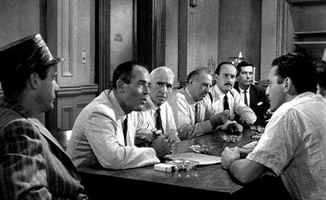As Bill Gates closed the door for the final time Friday on his ex-office (Ballmer takes over Monday) the rhetoric about continued one day a week doesn’t match the reality. Whether you believe Bill will have an ongoing role in Office and Windows futures, I bet most of Bill’s input is already factored in by the owners of those two dominant sources of Microsoft revenue.
What comes next depends on whether Microsoft can pivot to the open Web paradigm as predicated in the Live Mesh strategy, or meander along while attempting to catch up in search and failing to buy Yahoo. You can find plenty of the latter analysis elsewhere, but here we’ll go for the throat of Microsoft’s disruptive opportunity by using a time-honored approach when faced with few facts but a lot of clues. Namely, building a case out of circumstantial evidence. And a smoking gun.

The Usual Suspects
Steve Sinofsky – owns Windows 7, classic old guard Redmond power broker who made his bones by leading the design of Office 95 and 97’s shared technologies. A decade later, he owns both the high ground of the Windows franchise and the boat anchor of Vista’s miserable hope-draining failure.
Bob Muglia – owns Servers and Tools, highly profitable group including Windows Server, SQL Server, Visual Studio, Virtualization, System management, and security products. In other words, the infrastructure on which to deploy Live services once Microsoft moves to the Cloud.
Robbie Bach/J. Allard – together they own the entertainment and mobility platforms, most importantly Xbox, Zune, and Windows Mobile. Mobile is one of three pillars of Windows 7, along with Windows Desktop and the Live Desktop.
The New Guy
Stephen Elop – owns Office, Microsoft Dynamics, and Unified Communications. Like the others, a member of the Senior Leadership team, Elop came from Juniper Networks after managing Macromedia’s absorption into Adobe. Unlike the others (who range from 15 to 20 years in Redmond), he arrived in January.
The Time Line
In concert with the Gates transition, Microsoft has begun revealing its Windows 7 plans. First, fix Vista. Sinofsky inherits the greatest channel in software history, namely the bits on most new machines. Forget the Back to XP crowd – buy a new machine, buy the OS. Sinofsky’s job: keep the trains running on time.
Second, Windows Mobile. Apple’s iPhone has certainly turned up the heat in percentage of Web clicks relative to Smartphone market share, but Microsoft enjoys a big lead in the power and sophistication of its developer tools. Blending the Windows desktop and Mobile platforms into a cohesive whole becomes mission critical, and the key to unlock that synergy is the Live Desktop.
Live Desktop
In August NBC will deliver 2200 hours of live Olympic coverage including more than 20 simultaneous live video streams, 3000 on-demand hours of full-event replays, metadata overlays of results, stats, analysis, and alerts, and all powered by Microsoft’s cross-platform Silverlight technology. The site’s plug-in page makes interesting reading, with Adobe Flash listed first followed by Windows Media Player, and Silverlight for “enhanced video experience for PC and Macintosh.”
This ecumenical support for Flash reinforces Bill Gates’ comments last year that users don’t care what Flash or Silverlight bits are on their machines, and can happily live with the small download and storage footprints of both. What they get with Silverlight, however, is a substantial subset of the .Net runtime, some 100 million installs by the time the torch lights in Beijing.
The Smoking Gun
On May 5, 2008 a document appeared on Microsoft’s Live Mesh site, Behind Live Mesh: Live Desktop architecture. Live Mesh is a tech preview of a platform for (initially) synchronization of data across multiple devices via a centralized cloud. Live Desktop, as the developer-targeted post describes, is a platfrom encompassing 4 elements: A generic presentation framework; Live Mesh communication layer; Live Desktop windowing system; and C# to JavaScript compilation with Script#.
In the words of the post’s author, Live Desktop developer Alex Himel, “When you view it today, you should see a visually appealing view of a desktop that works well cross-browser, performs responsively once loaded (and will soon load faster), and enables you to traverse your cloud.” Then, in the comments, Himel is prompted about what might come next, specifically Silverlight integration:
Currently, the Silverlight experience is limited to media. This feature was designed and implemented very close to the release as a way to validate Silverlight integration with our cloud and to offer a way to interact with media elements inline. You can expect to see significant iteration this summer around both this experience, as well as other uses of Silverlight within the desktop.
The current goal of the Live Desktop is to meet a lowest common denominator for basic functionality, and to offer an enhanced experience for users who do choose to download add-ons. A WPF version of the Live Desktop is unlikely because we want the Live Desktop to be available cross-platform and cross-browser. A Silverlight-only Live Desktop is certainly possible at some point in the future, but we are focusing on the HMTL/JavaScript version for now.
In other words, there is no plan to build Windows Presentation Foundation into Live Desktop but every intention of a Silverlight-only implementation. Such a Silverlight Desktop would accelerate demand for some version of cross-platform/browser Office functionality, particularly built around RSS and unified communications (aka public IM), the fundamentals of the Live Mesh tech preview that will be launched into a developer beta in October at the PDC.

The Summation
Ladies and gentleman of the Jury: With 100 million Live desktops, Stephen Elop’s seven years of intimate knowledge of the Adobe/Macromedia agenda combined with Silverlight’s advanced engineering of not just rich media but rich behavioral tracking and ad management and reporting, a revenue-generating Live Office beachhead seems imminent. When the realignment of power in Redmond consolidates, Sinofsky will be pinned down with a Windows 2009 or 10 release, Muglia will be powering Live Desktop with services from his profitable server group, Bach and Allard will be aligning Windows Mobile and Windows Desktop via the Live Desktop bridge – and Elop will be in the marketplace anywhere from a year to 2 ahead of any other group.
The Live Desktop is Mesh plus Silverlight. A Silverlight Office, however iteratively it is rolled out, will provide Microsoft the leverage to frame the discussion of an Internet Operating System. By mandating openness at all costs combined with a clear user contract trading software for services, the strategy puts Google and Apple in the position of explaining how they too get from here to there. Perhaps a SIlverlight-like runtime from either company is in the pipeline, but more likely are the Gears and SproutCore developer frameworks which are lighter-weight and less fundamental to each companies’ current success.
Contorting the words of Johnnie Cochran, if the glove fits you must convict. Will a Silverlight-only Live Desktop emerge soon after Election Day? If so, what will Microsoft or its developers do with it? Will Ray Ozzie, who spent the first half of his career as the most successful third-party application developer in Windows NT’s history with Lotus Notes, lead a wave of Live Desktop development under the rubric of Services with just enough Software? If the Himel post goes 404, maybe not.